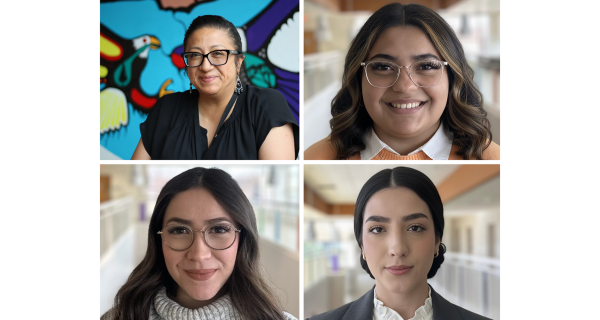Community Health Workers Drive Responsive Health Programs
Community health workers (CHWs) are at the heart of Michigan CEAL’s approach to public health programming. Through the Health Impact 360 (HI360) initiative, CHWs have played a central role in building trust, shaping a responsive intervention, and ensuring that the program reflects the lived experiences of the communities they serve. This Q&A features insights from four of the program’s CHWs: Luisa Carrillo of Detroit Hispanic Development Corporation and Estephany Angulo, Fatima Martin, and Noemi Hernandez-Gonzalez of the Community Health and Social Service Center. Together, they share their experiences co-designing public health interventions, engaging their communities, and advocating for stronger integration of CHWs into public health systems.
What are the benefits of co-designing public health interventions with CHWs?
Martin: Co-designing public health interventions with CHWs strengthens both the impact and sustainability of health programs. As trusted members of our communities, CHWs help ensure interventions are culturally relevant, accessible, and responsive to local needs. Our close connection allows us to identify challenges and barriers that may not be visible to outside professionals, making the interventions more practical and effective. CHWs also shape communication strategies using language and methods that resonate with the community. This builds trust, encourages participation, and improves health literacy. Programs planned with CHWs tend to achieve higher engagement and better outcomes because they reflect lived experiences. Co-designing not only empowers CHWs, but also fosters stronger partnerships between health systems and the communities they serve.
Carrillo: CHWs’ expertise lies in the communities they serve, where triumphs and hardships are known only to those who coexist within the community. This unique insight helps guide the approach and timing of public health interventions.
How did your relationships within the community help build trust and engagement in the HI360 program?
Martin: My relationships within the community played a key role in building trust and engagement in the HI360 program. With strong connections already in place, community members felt comfortable approaching me with questions and concerns. Many were more willing to participate because they recognized me as someone who understood their needs, respected their culture, and genuinely cared about their well-being.
These relationships broke down barriers that might have prevented participation. Through open communication, active listening, and follow-up, I showed consistency and reliability — qualities that strengthened their confidence in me and the HI360 program. This trust encouraged more community involvement, sharing of experiences, and positive word-of-mouth, which ultimately boosted engagement and improved the program’s success.
What strategies did you use to ensure the program was responsive to participants?
Hernandez-Gonzalez: I made changes based on participants’ input, observed their participation levels, and offered individual attention and support.
Carrillo: The best strategy was to work out of a trusted community-based organization (CBO). The CHWs were hired and assigned through these CBOs and consequently had access to a pool of people already involved in community programs.
Can you share an example of a time when your input as a CHW directly influenced a change or improvement in the program?
Hernandez-Gonzalez: As part of my role, I supported data collection and guided many participants through the informed consent process. I ensured they clearly understood the purpose of the program, their rights, and how their information would be used. This helped build trust and ensured accurate, ethical data collection.
If you could advocate for one change in how CHWs are supported or integrated into public health systems, what would it be?
Angulo: I’d love to see CHWs really built into the public health system, not just brought in for short-term projects or emergencies. We’re out here building trust and connecting with folks every day, and that work deserves more consistent support. Just knowing there’s stability, room to grow, and that our voices are part of the bigger decisions would make a huge difference. When CHWs are stable and valued, communities are too.
What reflections do you have on the role of CHWs and your involvement with Michigan CEAL?
Carrillo: There is healing energy with community gatherings and support. To lead and organize the space for it is often a natural ability for CHWs.
Angulo: It’s been meaningful to be included and to bring our community’s voice into the work. The chance to build trust and share real stories from the ground has been powerful. Community engagement works best when it’s flexible, respectful, and rooted in listening.
For more information about CHWs, check out CEAL’s CHW Fact Sheet.

Top row (left to right): Luisa Carrillo, Detroit Hispanic Development Corporation; Noemi Hernandez-Gonzalez, Community Health and Social Service Center
Bottom row (left to right): Estephany Angulo-Nava, Community Health and Social Service Center; Fatima Martin, Community Health and Social Service Center
Last updated: November 14, 2025